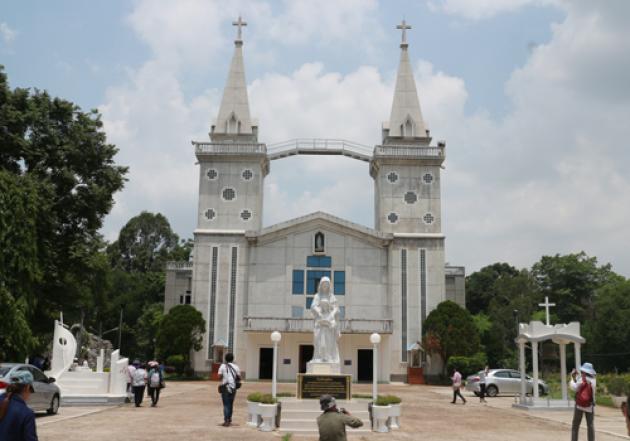All in the same boat

Facing one another across the Mekong, provinces in Thailand and Laos might soon capitalise further on their historic bonds
Talk about “citizens without borders”! Residents of Nakhon Phanom province used to casually cross the Mekong River to mingle with friends and business partners in Laos – or even to settle there – and the Lao did likewise, grabbing a boat from Khammouan province to see what was on the other shore.
It was an accepted facet of life along the river, as participants in a recent field trip discovered courtesy of the Thailand Research Fund (TRF). People from both sides of the river finally learned the reason for all the similarities in lifestyle and architecture in a region never wholly separated by the Mekong. They also got to exchange ideas about development and taking care of their natural resources.
The trip to Nakhon Phanom, 740 kilometres north of Bangkok, was aimed at promoting the TRF’s community-based research project on managing social and cultural tourism routes. The project, extending into Sakhon Nakhon and Mukdahan, will help Asean Economic Community policymakers assess tourism potential along that stretch of the river.
A case study focusing on the Chiang Khan-Khong Chiam link is likely to help harness the potential in tourism for Thailand, Laos and Vietnam and generally bring more visitors to the Thai Northeast.
Nakhon Phanom has long attracted travellers from elsewhere in Thailand as well as from Laos and Vietnam. The TRF has found evidence of a lengthy history of bonding among people in the area, fostered by close proximity and conflicts that provoked migration. Thousands of Vietnamese immigrated to Thailand due to political and religious issues at home and settled along the Mekong. Many Thais in the area today can claim Vietnamese ancestry.
Central Muang district in Nakhon Phanom is a small, quiet urban area that gradually evolved a multicultural society, the population including seven different Thai and Lao ethnic groups on top of citizens of Chinese and Vietnamese descent.
Sunthonvichit Road, which runs parallel with the Mekong, has several attractions that reflect the bonds forged among people from various countries.
Saint Ann’s Roman Catholic Church in Bang Nong Saeng, Tambon Nai Muang, was built in 1926 by a priest named Edouard Namlap, with impressive architecture mingling Thai, Lao and Vietnamese influences. An adjoining colonial-style building erected in 1952 – now home to the Edouard Namlap Foundation – features materials imported from Saigon.
The original church was bombed during the Indochina War – when communist North Vietnamese forces crossed the frontier with the US military in hot pursuit. But it was soon replaced and remains a place of pilgrimage every Christmas Eve for Catholics from across the province, who fashion beautiful Yuletide stars by hand.
Just down the road is the Governor of Nakhon Phanom Province Museum, nearly 100 years old. Its Western-style architecture bears the influence of France, colonial master of Indochina.
The 50-metre-tall Vietnamese Memorial Clock Tower was erected in 1960 by those who decided to return to their homeland after the war with the US. It expresses their gratitude for Thai friendship and refuge.
The Baan Lung Ho Museum is better known as “Uncle Ho’s House” because that’s where Ho Chi Minh and his band of revolutionaries lived from 1923 to 1931 while developing a strategy to restore Vietnam’s independence. It’s in the village of Ban Na Jok in Tambon Nong Yat.
Again, the original one-storey home was demolished, in its case after falling into disrepair, but later replaced. The compound is today filled with coconut, bamboo and betel-palm trees, just as it was during his seven-year stay, and many of his possessions are on display inside.
Also restored much to its former glory is the 57-metre-tall, Laotian-style chedi known as Phra That Phanom. The original was built more than 1,500 years ago to house the Lord Buddha’s breastbone, according to legend. The structure, glittering in gold and white, is still a centre of worship for both Thais and Lao.
Nakhon Phanom has six entry points to Laos – two permanent crossing points and four border checkpoints. The most important is the third Thai-Lao Friendship Checkpoint, established jointly by the two countries as the “gateway to Indochina”, which entails crossing the Thai-Lao Friendship Bridge. The bridge itself was officially opened on November 11, 2011, at 11 minutes past 11am, surely an auspicious moment for neighbours to join hands amid high hopes for trade and tourism.
On the eastern shore of the Mekong, Khammouan appears deeply fused to Nakhon Phanom, and they were indeed once part of the Sri Khotrabun kingdom.
The border city of Thakhek, provincial capital of Khammouan, has houses and other buildings in the French colonial style, recalling the architecture of neighbouring Savannakhet province, which sits opposite Thailand’s Mukdahan province. With its blessings of nostalgic charm, Thakhek is a must-visit destination for photographers, artists and history buffs.
The 21 March 1946 Memorial just outside the city recounts the struggle of Prince Souphanouvong and his Lao patriots – soldiers and civilians alike, joined by sympathetic Vietnamese – against French |military suppression. This is the story of how Laos gained its independence.
Also near Thakhek is Ban Chiang Wang, a community of Vietnamese-descended Lao and a genuine cultural melting pot. The local sights and particularly the food are wonderful. Ban Chiang Wang is famous for its incomparably soft pho noodles and bai pan, a sticky candy with a filling of green bean paste and shredded coconut flakes.
RELATED





